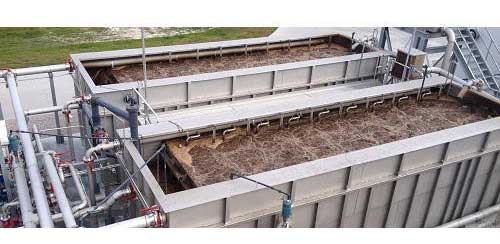
1. Secondary pollutants and tertiary filtration processes are excluded, thereby reducing factory footmark. In certain cases, footmark can be further reduced because other process units similar as digesters or UV disinfection can also be excluded minimised( dependent upon governing regulations)( CHAPMAN etal.n.y.).
2. Can be designed to protract sludge age, hence lower sludge product( CHAPMAN etal.n.y.).
3. High effluent quality.
4. High lading rate capability( LARSSON & PERSSON 2004).
1. High operation and capital costs( membranes).
2. Membrane complexity and fouling.
Energy costs.
Panse Consultants is a leading Manufacturer, Supplier, Exporter of Membrane Bio Reactor in Pune, Maharashtra. Effluent Treatment Plants (ETPs) play a critical role in maintaining environmental sustainability and promoting the health and safety of communities‘Membrane bio reactor ’( MBR) is generally a term used to define waste water treatment processes where a perm- picky membrane, eg microfiltration or ultrafiltration, is integrated with a natural process − specifically a suspended growth bioreactor.
Panse Consultants offers, Membrane Bio Reactor differ from ‘ polishing ’ processes where the membrane is employed as a separate tertiary treatment step with no return of the active biomass to the natural process.nearly all marketable MBR processes available moment use the membrane as a sludge, rejecting the solid accoutrements which are developed by the natural process, performing in a clarified and disinfected product effluent.
A Membrane bioreactor is basically a interpretation of the conventional actuated sludge( CAS) systemMembrane Bio reactors( MBR) are treatment processes, which integrate a perm- picky orsemi-permeable membrane with a natural process( JUDD 2011). It's the combination of a membrane process like microfiltration or ultrafiltration with a suspended growth bioreactor, and is now extensively used for external and artificial wastewater treatment with factory sizes up to 80 ’ 000 population coequals( BEDDOW 2010). Due to it being a veritably specialized result; it needs expert design and professed workers. likewise it's a expensive but effective treatment possibility. With the MBR technology, it's possible to upgrade old wastewater shops.
MBRs(membrane bioreactors) are generally defined as wastewater treatment processes in which a endless, picky membrane,e.g. microfiltration or ultrafiltration, is used in confluence with a natural process,e.g. a suspended growth bioreactor.It's important to separate the MBR process from traditional polishing processes in which the membrane is employed as a separate tertiary treatment step without introducing the active biomass into the natural process. The vast maturity of marketable MBR processes available moment use a membrane as a sludge, which removes the solid accoutrements generated during the natural process as a result of the natural process, performing in a product effluent that's clarified and disinfected. There is, of course, a need for verbose aeration. The membranes are personal and the throughputs per membrane module offered by different merchandisers differ, while each seller advocates colorful shapes of the membranes, including flat wastes, cross inflow, dead end inflow, etc, making it hard to establish a common design standard.
Microfiltration, nano- filtration, ultrafiltration, and natural wastewater treatment processes like ASP( Actuated SLUDGE PROCESS) are combined in this technology. Wastewater treatment has noway had it so well, thanks to this groundbreaking invention, which eliminates the conventional ASP's excrescencies, including a need for a huge quantum of fresh area for secondary pollutants and problems with liquid-solid separation. Because of its capacity to retain and sustain three to four times the quantum of mixed liquid suspended solids( MLSS) than is attainable in conventional aeration tanks, the treatment factory footmark is reduced.